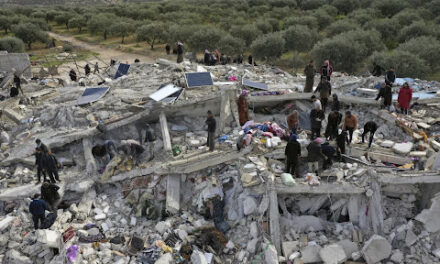Alexis Raymond, Staff Writer
As the Earth’s thermometer climbs up to the 1.5°C mark, which is a boundary once set by climate scientists as the critical limit to avoid catastrophic change, we are forced to confront a new and alarming reality. This isn’t just a potential breach of scientific thresholds; it’s a dire warning that the future we feared may soon be unfolding.
Image sourced from Washington Post Article
Last year, we experienced the hottest year on record, with our earth’s temperature sitting at about 1.48 degrees Celsius warmer than pre-industrial times. This is just 0.02 degrees shy of the Paris Agreement Limit, which was an agreement to limit global warming to 1.5 degrees Celsius as well as reduce greenhouse gas emissions. This happened at a much earlier time than predicted. Previously, climate scientists claimed we wouldn’t pass the 1.5-degree threshold until the 2030s. However, we’re just grazing it now and have been for the last couple of months. January of 2024 was the hottest January recorded since global record-keeping began in 1850. It sat at 1.66 degrees Celsius, which is a few digits over the limit that has been set. It doesn’t seem like a big deal, especially since the number is still so close to the original limit set, but climate scientists warned us about that number for a reason.
After continuously passing the 1.5-degree threshold, the world will change in ways that can’t be stopped once started. The changes caused by passing this threshold would be catastrophic and irreversible. It will trigger major tipping points such as the melting of polar ice sheets which would contribute to sea level rise. If this were to happen, around 13 million people would have to relocate due to the rise just in the US alone. Other than the slow rising of the sea, passing this limit also contributes to the natural disasters we are seeing more frequently. Heatwaves, floods, droughts, and wildfires will all continue to increase in amount and we will continuously be running from the effects of our gradually heating world. None of these things will happen instantly, it’s a slow and steady process that is nearly impossible to reverse. For every little bit of warming, the risk of impacts gets more alarming and harder to ignore.
There are many things we can do to try and stop the world from heating more. Using renewable energy is one that plenty of climate scientists recommend. Choosing a utility company that generates half of its power from wind or solar power is a way to help that has been certified by Green-e Energy, which is an organization that provides renewable energy options. Changing your utility company can be something that you may not want to do- and that’s fine too! If you look at your electric bill, some utilities may list other ways to support renewable sources. Recycling is another important aspect of controlling climate change. When we recycle, the materials are reused rather than just disposed of in landfills. The waste in landfills generates methane, a potent greenhouse gas that can trap heat in the atmosphere.
As we stand at the crossroads of climate crisis and action, each choice and every step towards sustainability becomes key in steering our planet away from irreversible damage. Embracing renewable energy and committing to recycling are more than just necessary; they are our joint lifeline. By acting now, we not only preserve our world for future generations but also show our resilience in the face of global challenges.
Sources:
https://www.washingtonpost.com/climate-environment/2024/02/08/1-5-celsius-global-warming-record/#





